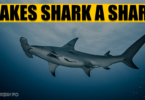In the oceans, sharks are a few of the species that are somewhat easy to identify, all thanks to their streamlined body structure, fins, and, most importantly, big mouths full of teeth. Portrayed as giant beasts and the monster killer, sharks are distributed throughout the world’s oceans and have diversified into over 500 species.
The large pool of species inevitably brings with it many strange and weird-looking sharks, which may make you faint when you see them for the first time. Not if you know the names and a few specifics earlier. Let’s take a look at a few species and see if we can prevent the fear from taking hold.
1: Goblin Shark
Deep-sea sharks with pink skin have drawn-out, flat snouts and bloated teeth with the appearance of nail-like nails. Prey can be caught by goblin sharks by thrusting their jaws out for about three inches.

Quick facts
- The only living member of the family Mitsukurinidae
- It has a distinctive pink coloration
- It can grow to an approximate size of 12 feet long
2: Helicoprion Shark
During the early Permian Period, these creatures lived in the oceans throughout the world and exhibited curved teeth resembling circular saws. As far as the physical characteristics of this shark go, the only fossils that have been found are its teeth.

Quick facts
- A prehistoric shark that lived during the Early Permian period
- It is known for its distinctive, spiral-shaped tooth whorl
- Chimeras are the closest and only living relatives of Helicoprion in the current era
3: Frilled Shark
An unusual, prehistoric-looking shark, it lives in the ocean’s open waters, often deep down the surface. Almost seven feet in length, its body is cylindrical and has fins on the body. Frilled sharks are named for the six slits along their throat that appear fringed.

Quick facts
- The frilled shark has a long, snake-like body with six pairs of gill slits
- It is a slow-moving predator that uses its long body and frilled teeth to capture prey
- Approximately 300 teeth are arranged in 25 rows of backward-facing trident shapes
4: Sawshark
With a saw-like snout edged with sharp teeth, sawsharks have made their mark on the list of weirdest-looking sharks. An adult saw shark can reach a maximum length of 4.5 feet. Their saws are used to strike and cut their prey when feeding.

Quick facts
- Long barbels line the snout of sawsharks
- Dermal denticles cover the saw shark’s body
- Large and small teeth are typically alternated on the saw
5: Wobbegong shark
A wobbegong is a bottom-dwelling shark that spends a considerable amount of time on the sea floor resting. The ornate patterns on their bodies give them the appearance of lumpy carpets, which is why they are also called carpet sharks.

Quick facts
- The Wobbegong shark is a nocturnal predator
- Considered to be harmless to humans, but it has a tendency to attack
- The bite of these animals can be severe because of their many sharp teeth, though small
6: Basking Shark
Despite the species not being dangerous, their size is what earns them a place on this list; the second largest shark in terms of size. With a length of 40 feet and a weight of over 5 tons, it is frequently seen swimming close to the surface of the water.

Quick facts
- The Basking shark is a filter feeder shark relying mainly on zooplankton
- Humans are not at risk in general, but they are large, and their skin is rough, so caution is advised
7: Greenland Shark
It mainly inhabits cold-water environments such as those in the Arctic Ocean and North Atlantic Ocean. Often between 8–14 feet in length, it has a rounded snout, small fins, and gray to brown coloration.

Quick facts
- In comparison to all vertebrates, the Greenland shark has the longest lifespan known
- Since it is isolated from human activity, no attacks have been reported
8: Cookiecutter Shark
The cookie-cutter shark is a small, deep-sea shark known for its unique feeding habits. This shark uses its long, sharp teeth to take “cookie-sized” bites out of larger animals, including other sharks. The cookie-cutter shark is found in temperate waters worldwide.

Quick facts
- Photophores in the cookiecutter’s skin emit light, making its whole underside glow
- They are often found swimming at depths below 3200 feet, so you are unlikely to see a Cookiecutter Shark
9: Phoebodus shark
The Phoebodus shark is a prehistoric shark that existed during the Devonian period. It was a large shark, reaching up to 6 meters in length. It had a long, trim body and a pointed snout. Its teeth were sharp and rounded, and it had large eyes.

Quick facts
- Phoebodus sharks went extinct early in the Carboniferous, according to investigators
10: Anvil Shark
As one of the earliest sharks, Stethacanthus measures about 70 centimeters long. It is endemic to the waters of southern Japan and is named for its anvil-shaped first dorsal fin.

Quick facts
- Known for its peculiar dorsal fin, this small shark lived around 350 million years ago
11: Velvet belly lanternshark
Sharks with velvet belly undersides are named so because their black undersides starkly contrast with the brown coloration of their bodies. Velvet belly sharks are usually no more than 18 inches long.

Quick facts
- Velvet belly lantern sharks emit light with photophores, making them bioluminescent
- Ovoviviparous; every 2 to 3 years, it gives birth to litters of 6 to 20 young
- In the northeastern Atlantic Ocean, velvet belly sharks are quite abundant
12: Scissor-tooth Shark
An extinct mysterious fish with a long v-shaped root system and numerous serrated teeth, Edestus has long curls of teeth.

Quick facts
- Its teeth are sharp and curved, like a pair of scissors
- According to conservative estimates, E. heinrichi can grow to a length of more than 22 feet
13: Swell shark
Swell sharks have a yellow-brown body color that is speckled with brown and white. An average swell shark measures 90 cm in length, with a maximum of 110 cm. There is a high level of social interaction among these species, and it is common to see them sleeping on top of or next to other sharks.

Quick facts
- Upon swallowing water, a swell shark expands approximately two times its normal size
- The number of teeth in a swell shark is usually between 55 and 60
14: Dwarf Lantern Shark
At maturity, it reaches a maximum known length of only eight inches and is characterized by a long flattened head and black ventral markings.

Quick facts
- Out of all shark species, it is the smallest one dwelling in the oceans
- As the name suggests, it has elements on its body that emit lights
15: Thresher Shark
The thresher shark is an enormous pelagic fish that is to be present in all major oceans. It is easily eminent from other sharks by its long, scythe-like tail. The thresher shark is a fast and agile swimmer and is known to jump out of the water when chasing prey. It feeds mainly on small fish and squid but can also take larger prey items such as dolphins and seals. The thresher shark does not reflect a threat to humans but can be dangerous if provoked.

Quick facts
- It is an ovoviviparous species of shark that reproduces every year
- Thresher sharks generate heat through their internal body mechanisms like shivering muscles
16: Cyclops dusky shark
The Cyclops dusky shark is a type of requiem shark belonging to the family Carcharhinidae. A large and powerful predator, it is capable of inflicting serious injuries on humans.

Quick facts
- Dusky sharks reach lengths of up to 14 feet, making them one of the largest species in their genus
- It takes dusky sharks around 20 years to reach adulthood, making them among the slowest-growing sharks
- Its slow reproductive rate makes it extremely vulnerable to extinction
17: Hammerhead Shark
The hammerhead shark is a type of shark that is easily recognizable by its exclusive head shape, which resembles a hammer. These sharks are found in temperate waters worldwide and can grow to be up to 20 feet long.

Quick facts
- Despite their intimidating appearance, hammerhead sharks are not considered to be a threat to humans
- Hammerhead shark uses its head as a weapon when going after prey
18: Godzilla shark
Godzilla shark: an ancient shark relative discovered in 2013 and given its own species name after being classified for the first time. 12 rows of teeth with robust, powerful jaws are the most distinguishing features of the skeleton of this prehistorical species.

Quick facts
- Due to its massive size, the shark was nicknamed the Godzilla shark
Conclusion
Oceans are full of incredible and yet the most horrifying creatures you will ever see. The quest to explore the underwater world is not a new concept, but anyone going down there should be aware of the habitat, especially when it comes to the dangerous beasts, the sharks. In the world of species, there are hundreds that are so different, or you could say strange and weird-looking, that you forget everything else. For instance, take the example of the goblin shark, frilled shark, and sawshark.







